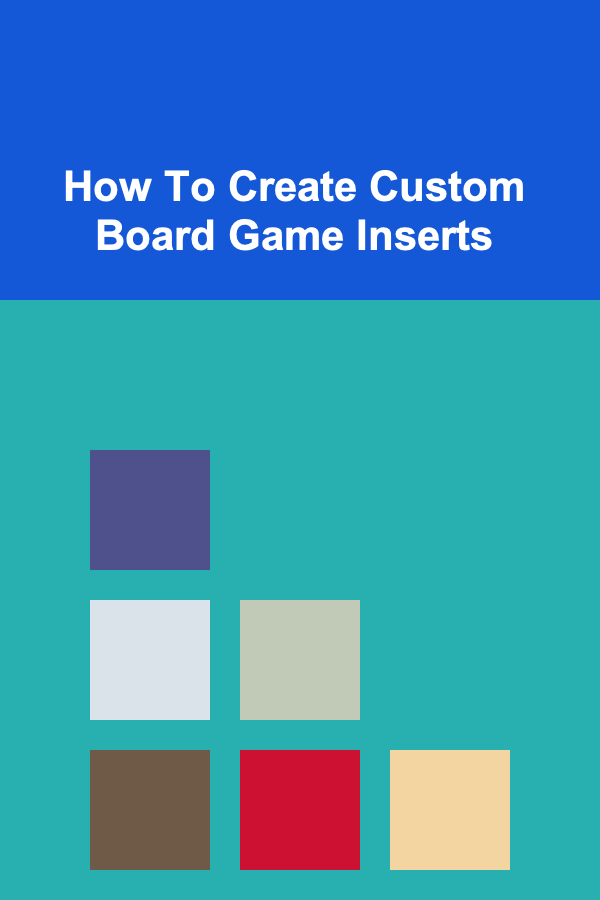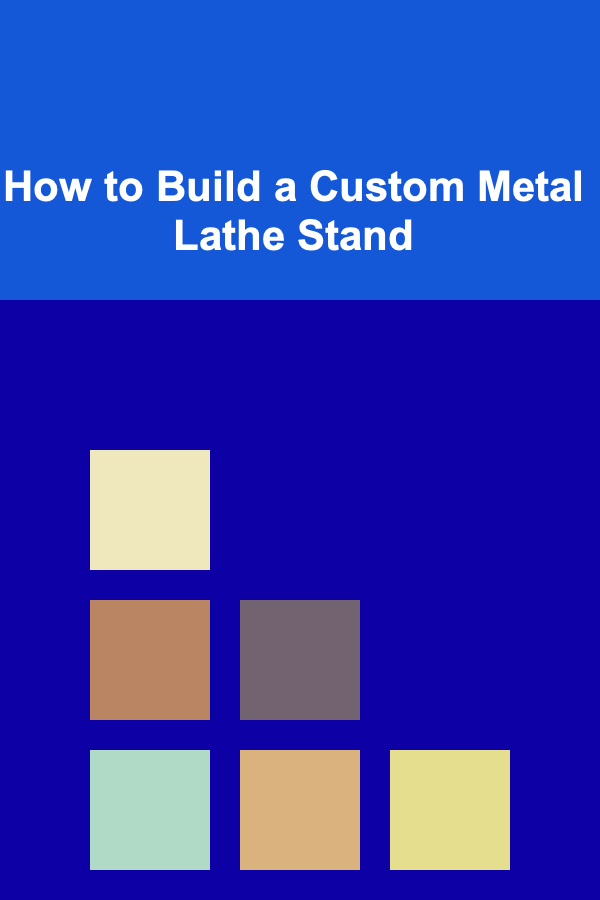
How To Create Custom Board Game Inserts
ebook include PDF & Audio bundle (Micro Guide)
$12.99$8.99
Limited Time Offer! Order within the next:

Board games have become a popular hobby for many, offering a way to connect with friends and family while engaging in fun and challenging gameplay. For enthusiasts, one aspect of board games that often goes unnoticed but plays a crucial role in the enjoyment and longevity of the game is the organization of the game components. Over time, many board games accumulate an assortment of cards, tokens, dice, boards, and other small pieces that, when not properly organized, can lead to frustration during setup and gameplay. Custom board game inserts solve this problem by providing a neatly organized, visually appealing, and functional solution.
Creating a custom board game insert is a great way to enhance the gameplay experience and preserve the quality of the components. Whether you're an experienced crafter or a beginner, this guide will walk you through the process of designing and creating a custom insert that will keep your game organized, easy to set up, and protected from wear and tear.
Understanding the Need for Board Game Inserts
Before diving into the design and creation process, it's essential to understand why inserts are important. A well-designed insert does more than simply store components -- it improves the overall gaming experience. Here are a few reasons why custom inserts are valuable:
- Organization: Many board games come with a variety of components, such as cards, tokens, miniatures, and dice, which can become difficult to manage without proper organization. An insert allows each item to have a dedicated space, ensuring everything is easily accessible.
- Storage: Not all board game boxes are designed to hold the game components neatly. An insert helps maximize the available space, reducing the chance of pieces getting damaged or lost.
- Time Efficiency: With an insert, game setup and teardown are faster because you know exactly where each component goes. This saves time and keeps the gameplay experience smooth and enjoyable.
- Preservation of Components: A custom insert can help protect your game components from damage, such as bent cards, scratched tokens, or broken miniatures. The insert provides cushioning and proper support.
- Personalization: Designing a custom insert allows you to tailor it to your game's specific needs, ensuring the best possible fit for your components.
With these benefits in mind, let's take a look at how you can create your own custom insert.
Step 1: Analyze Your Board Game
Before you start designing your insert, you need to carefully analyze the game. This step is crucial because it helps you determine the number and type of components you will need to store, as well as the available space in the box. Follow these steps:
1.1. Gather All Components
Start by taking out every component of the game, including cards, dice, tokens, boards, and any other pieces that may be included. Lay them out in front of you so you can get a clear sense of the number of items you need to organize.
1.2. Categorize the Components
Once you have all the pieces laid out, group them by type. For example, place all the cards in one pile, the tokens in another, and the miniatures in yet another. This step will help you determine the different sections and compartments needed for the insert.
1.3. Measure the Box
Using a ruler or measuring tape, measure the internal dimensions of the board game box. Be sure to measure both the length and width of the box, as well as its depth. This will help you plan the size of your insert and ensure it fits perfectly inside the box.
1.4. Determine Your Storage Needs
Consider how many compartments you need and the size of each one. Some components, like cards, may require a large, flat compartment, while others, like dice or tokens, might need smaller, divided sections. Take into account how often you plan to access each component, as this will influence the layout of your insert.
Step 2: Plan Your Insert Design
With your analysis complete, it's time to plan the design of your custom insert. This is the step where you can get creative and design an insert that fits your game perfectly.
2.1. Sketch Your Design
Start by sketching a basic layout of your insert. You can either do this on paper or use design software if you are comfortable with digital tools. Draw the internal shape of the board game box and begin dividing it into sections based on the components you need to store.
Consider the following layout options:
- Flat compartments for large items like cards or boards.
- Stacked compartments for smaller components like tokens or miniatures.
- Drawers or trays for items that need to be easily removed and accessed during gameplay.
2.2. Optimize Space Usage
Maximizing the use of available space is important for ensuring that your insert is efficient. If you have small components, consider using dividers to create multiple smaller sections within a single compartment. This will help keep items organized and prevent them from mixing together.
Additionally, think about the accessibility of the components. The most frequently used items, such as cards or tokens, should be placed in the most accessible compartments, while less frequently used components, like extra game boards or rules, can be placed in harder-to-reach sections.
2.3. Consider Materials
The material you use for your insert will impact its durability, appearance, and ease of construction. Some popular materials for custom inserts include:
- Cardboard: A lightweight and affordable material that is easy to cut and shape. Cardboard is a good choice if you are looking for a simple, budget-friendly insert.
- MDF (Medium Density Fiberboard): A sturdier material that can be laser cut or manually assembled. MDF is durable and offers a professional look but may require more tools and expertise to work with.
- 3D Printing: If you have access to a 3D printer, you can design and print custom compartments for your insert. This method allows for precise, intricate designs but requires access to specialized equipment and software.
Consider the weight of your components and how much durability you need before choosing a material.
Step 3: Build the Insert
Once your design is complete, it's time to bring it to life. The process will vary depending on the material you've chosen, but the general steps are as follows:
3.1. Gather Tools and Materials
Before you start building, ensure you have all the necessary tools and materials. For cardboard inserts, you'll need:
- Scissors or a utility knife
- Ruler and pencil
- Glue or double-sided tape
For MDF or laser-cut inserts, you may need:
- Laser cutter (if you have access to one)
- Wood glue
- Sandpaper
For 3D-printed inserts, ensure your printer is ready and you have the appropriate filament.
3.2. Cut the Pieces
Using your design as a guide, cut out the individual pieces for your insert. For cardboard inserts, carefully measure and cut the pieces with a utility knife. If you're working with MDF, you may need a saw or laser cutter to create the components.
3.3. Assemble the Insert
Once all the pieces are cut, begin assembling the insert. Start by gluing or taping the larger sections together, such as the base and sides. Then, add the dividers and smaller compartments. Be sure to allow time for the glue to dry before moving on to the next step.
3.4. Test the Fit
After assembling the insert, test the fit by placing it inside the game box. Ensure that it fits snugly and that all the components can be stored in their designated compartments. If necessary, make adjustments to the design.
3.5. Finishing Touches
Once the insert is assembled and everything fits properly, you can add any finishing touches. This may include painting or decorating the insert to match the aesthetic of your game, adding labels to the compartments for easier identification, or reinforcing the edges for added durability.
Step 4: Organize Your Game Components
With your custom insert complete, it's time to organize the game components. Begin by sorting all the pieces into their appropriate compartments. Place the components in a way that makes sense for gameplay -- for example, cards might go in one compartment, tokens in another, and miniatures in a third.
Step 5: Enjoy Your Organized Game
With everything neatly organized in your custom insert, you'll be able to enjoy a more streamlined and enjoyable gaming experience. The setup will be quicker, the components will be protected, and you'll be able to focus on the fun of the game rather than searching for missing pieces.
Conclusion
Creating a custom board game insert is a rewarding project that enhances both the aesthetics and functionality of your games. By taking the time to design and build a personalized insert, you can ensure that your board game experience is more organized, efficient, and enjoyable. Whether you're using cardboard, MDF, or 3D printing, the process is relatively straightforward, and the result will be a game that is well-protected and easy to set up.
So grab your materials, unleash your creativity, and start crafting the perfect insert for your favorite board games!
Reading More From Our Other Websites
- [Home Budget Decorating 101] How to Design a Budget-Friendly Outdoor Space
- [Organization Tip 101] How to Create a Drop Zone for Clothes Needing Washing
- [Home Staging 101] How to Create a Cozy and Inviting Master Bedroom for Potential Buyers
- [Home Holiday Decoration 101] How to Make Festive Holiday Cocktails for Your Parties
- [Organization Tip 101] How to Use Wall Hooks for Better Space Management
- [Home Rental Property 101] How to Use Online Platforms to Market Your Rental Property
- [Home Rental Property 101] How to Create a Positive Experience for Long-Term Tenants
- [Horseback Riding Tip 101] Advanced Riding Cues: How to Communicate Effectively with Your Horse in the Saddle
- [Home Pet Care 101] How to Implement DIY Pet Dental Cleaning Tips to Avoid High Veterinary Expenses
- [Personal Financial Planning 101] How to Build an Emergency Fund with Minimal Income

How to Build a Checklist for Maintaining Consistency in Content Creation
Read More
How to Create the Perfect Party Ambiance with Candles and Mood Lighting
Read More
How to Plan Your Taxes to Keep More Money in Your Pocket
Read More
How to Renovate Your Home for a More Modern and Sleek Aesthetic
Read More
How to Knit a Project Planner That Actually Works
Read More
How to Build a Custom Metal Lathe Stand
Read MoreOther Products

How to Build a Checklist for Maintaining Consistency in Content Creation
Read More
How to Create the Perfect Party Ambiance with Candles and Mood Lighting
Read More
How to Plan Your Taxes to Keep More Money in Your Pocket
Read More
How to Renovate Your Home for a More Modern and Sleek Aesthetic
Read More
How to Knit a Project Planner That Actually Works
Read More